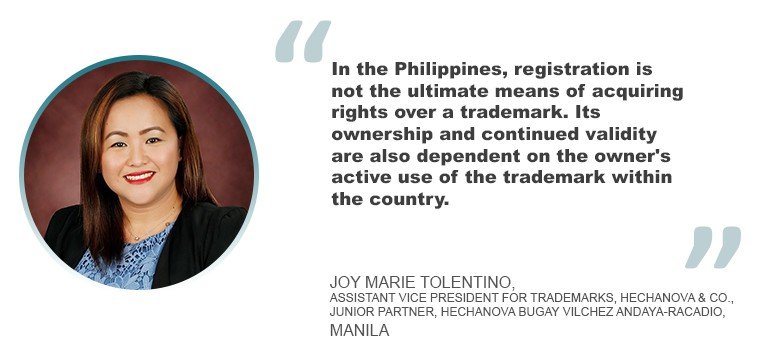Maintaining rights over time – how the Philippines does it
01 July 2024

Beyond initial registration, declarations of actual use ensure ongoing trademark usage, promoting innovation and competition. Excel V. Dyquiangco explains how this regulatory measure combats against trademark piracy and encourage genuine use.
Securing rights through trademarks is only the first step when safeguarding the fruits of innovation. The next is to maintain these rights effectively over time, and in many jurisdictions, including the Philippines, this is through declarations of actual use (DAU). This practice is more than just procedural – it is a vital foundation that maintains the dynamic balance of intellectual property systems around the globe. Its importance can’t be overemphasized for both the owners of the rights as well as the larger innovation ecosystems.
The need to submit a DAU emphasizes the idea that intellectual property rights are granted to encourage innovation as well as guarantee their use. Trademarks can’t serve their primary purpose of differentiating products or services in the market unless they are actively employed in businesses. Therefore, a DAU acts as a gatekeeper to make sure that marks aren’t just kept on hand, which can inhibit innovation and competition.
According to Joy Marie Tolentino, an assistant vice president for trademarks at Hechanova & Co. and junior partner at Hechanova Bugay Vilchez Andaya-Racadio in Manila, ensuring that your trademark registration remains valid and enforceable requires several maintenance requirements.

“In the Philippines, registration is not the ultimate means of acquiring rights over a trademark. Its ownership and continued validity are also dependent on the owner's active use of the trademark within the country,” she said.
She added: “Under existing Philippine trademark regulations, a declaration of actual use is a sworn statement, duly signed by the trademark owner or a representative. The DAU essentially contains statements to the effect that the trademark is being used in the Philippines, that it is being used for the goods and services identified, and that goods are being sold or the services are being rendered at a specific store or location in the Philippines or through a specific website.”
A DAU is to be submitted to the Intellectual Property Office of the Philippines (IPOPHL) according to the following schedule:
-
Within three years from the filing of the trademark application or from the international registration date or subsequent designation date.
-
Within one year from the fifth anniversary of the registration of the mark, the renewal of registration or the statement of grant of protection.
-
As per Rule 204 of IPOPHL MC No. 17-010, a DAU must be submitted for renewed registrations within one year from the date of renewal of the registration. This requirement only applies to registered marks due for renewal on January 1, 2017, and onwards, regardless of the filing date of the Request for Renewal. – RENEWAL DAU
“The filing of the third-year DAU may be extended once for a period of six months, provided that the request was made before the three-year period expired and upon payment of the necessary fees. As to the two other types of DAUs, extension is not possible,” she said. “Thus, the fifth-year DAU and the Renewal DAU should be filed when they become due. Otherwise, their non-filing will result in the removal of the registration from the registry.”
However, if an applicant or registrant has valid reasons that prohibit him from using the mark, a declaration of non-use may be filed in lieu of the DAU. However, the non-use of a mark may only be excused in the following circumstances:
-
The registered owner is prevented from using it as a requirement imposed by another government agency.
-
An existing restraining order or injunction issued by a court, the IP office or other quasi-judicial bodies prevents the use.
-
The mark is the subject of an opposition or cancellation case.
Arjel P. de Guzman, a partner at de Guzman Mayuga in Manila, said that the DAU requirement would require trademark owners and registrants to be realistic in prosecuting their applications.
“Upon entry, the IP office does not require a DAU or any declaration of intent to use the mark in relation to the goods and services covered by the application,” he said. “This creates a wide latitude for applicants to elect as many classes as possible when they lodge their applications. However, they have to take note of the DAU requirement and the fact that being unable to use the mark in some of the classes included in the application would result in the cancellation of the registration in those classes where the registrant is unable to file a DAU.”

He added: “As to optimal timing for filing, any trademark practitioner worth his salt would advise a registrant to submit a DAU at the earliest instance possible. Early filing would obviously provide a leeway in terms of resolving any issues or concerns that may arise in the examination of specimens and with the actual use of the mark itself.”
DAU inclusion
The Trademark Regulations provide for the acceptable forms of specimen to prove use in the Philippines. These include:
-
Labels of the marks as used;
-
Downloaded pages from the registrant’s website clearly showing that the goods are being sold or the services are being rendered in the Philippines;
-
Photographs of labels or goods bearing the marks as they are used;
-
Brochures or advertising materials showing the use of the mark in the Philippines;
-
For online sales, receipts of the sale of goods, services rendered or other similar evidence of use, showing that the goods are placed on the market or the services are available in the Philippines or that the transaction took place in the Philippines;
-
Copies of contract for services showing the use of the mark.
“The forms of evidence and specimens would vary for different industries, of course. However, what is important is for the registrant to show through sufficient proof and specimen that the goods and services covered by the mark are available for Philippine consumers,” said de Guzman. “To date, the most convenient proof would be excerpts from websites or online platforms showing that the goods are being sold to Philippine consumers or that the services are made available in the Philippines.”
If you plan to expand trademark use into additional good or service categories in the future, he advised to note that the DAU requirement is an incident of registration.
“Thus, if a trademark owner wishes to expand the coverage of his mark, thereby adding several goods or services, additional registrations to cover the included goods or services may be needed,” said de Guzman. “In turn, the additional DAUs that are specific for such additional filings would also be necessary.”
Strengthening trademarks
In cases where a competitor might be using a confusingly similar mark, how does filing a DAU strengthen the company’s position in potential legal action against them?
“Filing of DAUs as prescribed under Philippine intellectual property laws and regulations allows registrants to maintain the protection and registration of the mark,” said Kristine Bongcaron, a partner at Martinez Vergara & Gonzalez Sociedad in Manila. “Registration of marks is a condition for a number of administrative enforcement actions (filing of complaints before the Bureau of Legal Affairs or the Intellectual Property Rights Enforcement Office). As such, maintenance of the registered mark through the regular filing of DAUs gives the registrant more viable remedies, in case of legal action.”
She added that in terms of any recent legal cases or trends in the Philippines related to DAUs, particularly concerning the type of evidence accepted or challenges faced during the filing process, reflecting the trend of availing goods and services via online transactions, proof of actual use of the registered trademark may now consist of downloaded pages from websites clearly showing that the goods or the services bearing the mark are sold or rendered or made available in the Philippines.

“Previously, registrants must identify addresses of at least two actual physical locations where the covered goods and services are offered and rendered. Now, the addresses indicated in the DAU need not be physical locations but website links,” said Bongcaron.
This was illustrated in the case of W Land Holding v. Starwood Hotels and Resorts Worldwide, G.R. No. 222366, on December 4, 2017, where the actual use of the trademark via the internet and providing proof thereof to comply with the DAU requirements have been established.
The law now recognizes, among others, “downloaded pages from the website of the applicant or registrant clearly showing that the goods are being sold or the services are being rendered in the Philippines,” as well as “for online sale, receipts of sale of the goods or services rendered or other similar evidence of use, showing that the goods are placed on the market or the services are available in the Philippines or that the transaction took place in the Philippines,” as acceptable proof of actual use.”
Jaime Fernandez, an associate at Martinez Vergara & Gonzalez Sociedad in Manila, reiterated: “The filing of the DAU is primarily intended as a regulatory measure to support the Philippines’ first-to-file system.

The DAU ensures that trademark applicants or owners maintain and make use of their registered marks. This deters the practice of stockpiling marks without a genuine intention of using the same only to block future registrants. It also deters the practice of trademark squatting, or where a party registers a trademark in bad faith by filing applications for another’s mark in a jurisdiction where such mark has not been registered.”






